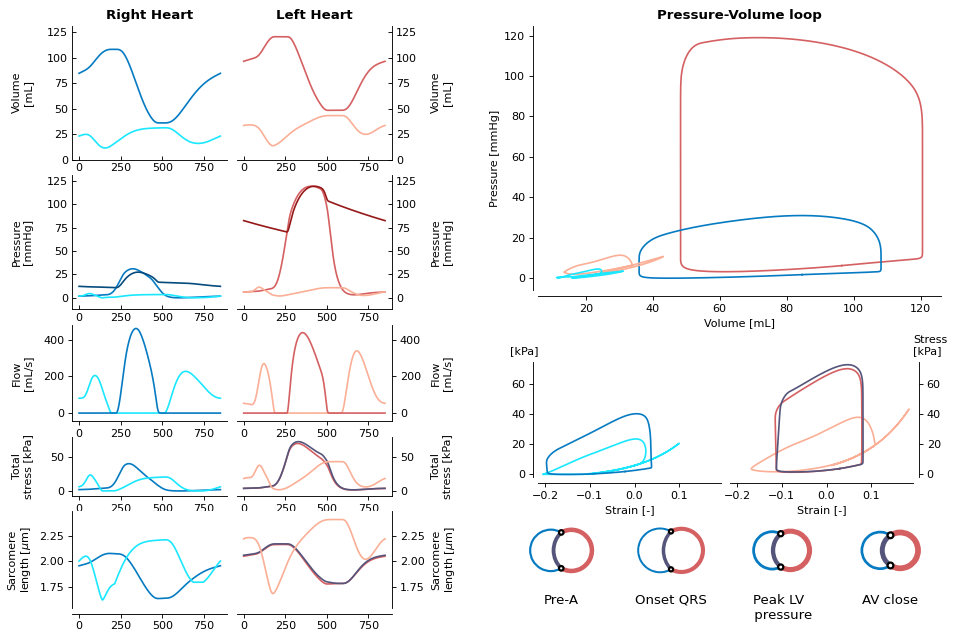VanOsta2024
|
Todo
Create a visualization of VanOsta2024
The VanOsta2024 model was initially introduced in [?]. It is founded on the CircAdapt model published by Walmsley in 2015 [?]. On this page, a general description is given on the model. More details can be found in VanOsta2024.
Physiological Description
This model represents a rapid biomechanical lumped-parameter approach to simulate the intricacies of the heart and circulatory system. It uses a one-fiber model (Chamber2022 and Wall2022) to establish the wall stress and cavity pressure relationship. The TriSeg module facilitates inter-ventricular interaction across the Intra-Ventricular Septum (IVS) (TriSeg2022). Phenomenological material laws define the active and passive stress–strain relationship in the spherical walls (Patch2022). The MultiPatch module introduces regional heterogeneity of tissue properties within a single wall (Wall2022).
Additionally, a reduced-order circulation is implemented, with systemic and pulmonary arteries and veins modeled using a single Tube0D each. The flow across systemic and pulmonary capillaries is simulated using the ArtVen module. Flow from atria to ventricles, from ventricles to arteries, and from veins to atria are simulated by means of the Valve2022 module.
At a global scale, the Timings module manages atrial and ventricular activation. Homeostatic control can be regulated through PressureFlowControl when activated.
Model |
Literature |
unit |
Source |
|
|---|---|---|---|---|
HR |
70.6 |
|||
SBP |
119.1 |
mmHg |
||
DBP |
70.3 |
mmHg |
||
LVEDV |
120.6 |
121 pm 31 |
mL |
Addetia et al.[1] |
LVESV |
48.3 |
47 pm 15 |
mL |
Addetia et al.[1] |
LVEF |
59.9 |
61 pm 5 |
% |
Addetia et al.[1] |
RVEDV |
108.2 |
mL |
||
RVESV |
35.9 |
mL |
||
RVEF |
55.3 |
% |
||
LAVmax |
43.2 |
mL |
||
LAVmin |
13.5 |
mL |
||
RAVmax |
31.2 |
mL |
||
RAVmin |
11.3 |
mL |
||
mLAP |
6.5 |
mmHg |
||
mRAP |
1.9 |
mmHg |
||
mPAP |
16.1 |
mmHg |
Model assumptions and parameterizations
Valve
Inertia
TODO
Provide details on the included solver.
Explain the solving strategy.
Present the initial parameterization.
Discuss the model verification process.
Explain adaptation protocol
Solving strategy
Todo
Update overview of the framework and its solving strategy.
Each module in the CircAdapt framework is implemented as a component. Components are the smallest objects that can be isolated in the cardiovascular system. All Modules together form the ordinary differential equations, which are solved using one of the implemented Solvers. Depending on the complexity of the created model, an appropriate solver should be selected with appropriate step-size.
As components use eachothers (state-)variables, equations need to be calculated in the right order. Therefore, the strategy as shown in the figure below is used.
(Source code, png, hires.png, pdf)

Fig. 21 Default visualization of the model with its reference parameterization.